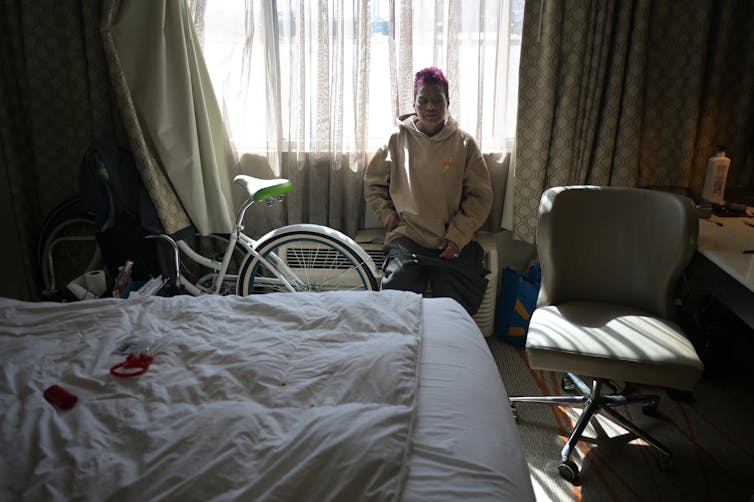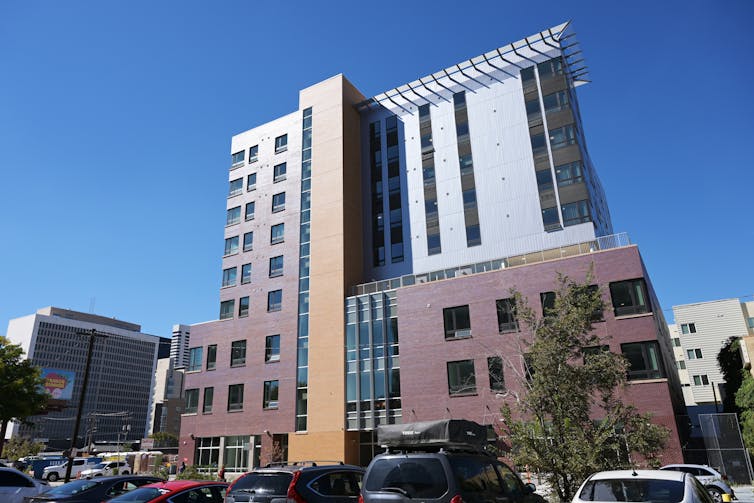On a recent early fall morning, hope was in short supply.
My first patient was a regular. Mr. D was a man in his 50s with diabetes. He had been living on Denver’s streets for most of the past five years, two of them with a walker in tow. Without stable housing and reliable access to insulin, he’d come to the hospital that morning with another limb-threatening infection.
I examined the telltale ulceration on the sole of his foot. It had progressed to the underlying bone and would require another amputation. This time he would be dependent on a wheelchair. I asked him about his prospects for housing. He shook his head and said, “Doc, I just keep falling through the cracks.”
Mr. D is one of the 10,774 people who experienced homelessness on a single night in 2025 across metro Denver, according to a count conducted by the Metro Denver Homeless Initiative and partner organizations. Of these, 35% were experiencing a chronic form of homelessness.
Joe Amon/Denver Post via Getty Images
As an internal medicine physician whose focus is caring for hospitalized patients, my experience suggests that this count is too low. People in hospitals and other institutional settings the day of the survey are not reflected in these numbers. Others are hard to spot, staying out of sight on couches or in creek beds, or hiding in plain sight while they serve our food or fix our roads. For these reasons, point-in-time counts underestimate the true prevalence of homelessness in the city.
I work at Denver Health, the region’s comprehensive safety net health system, where I’m on the front lines of Denver’s homelessness crisis. My perspectives on this issue have been shaped by nearly two decades of experience caring for some of the city’s most vulnerable patients.
I’ve helped create and oversee hospital partnerships that help people like Mr. D find housing. But recent federal actions will only worsen homelessness and weaken the response to it in Colorado and across the nation.
Falling through the cracks
When people like Mr. D fall through the cracks, my colleagues and I are there to catch them. In 2024, Denver Health served more than 16,000 patients experiencing homelessness who collectively had 78,000 visits to the integrated health system.
I’ve watched these cracks widen as Colorado has become one of the least affordable places in the country to live. According to a report by the National Low Income Housing Coalition, in 2025 a Coloradan can work more than 80 hours per week and still be unable to afford a one-bedroom apartment. This means that housing is woefully out of reach for many of my patients.
As physicians, we are trained to address the root causes of the diseases we treat. I care for elderly patients who are newly homeless following an eviction, as well as homeless veterans and Lyft drivers who sleep in their vehicles. Though their individual circumstances vary — loss of job or a loved one, an illness or a battle with addiction — the root cause of their homelessness is the same: a lack of affordable and available housing.
Because of an increased prevalence of serious health conditions and structural barriers – such as marginalization and discrimination – that prevent equitable access to primary and preventive health care, people experiencing homelessness often rely on hospitals like ours for care.
In 2024, roughly 1 in 6 adults admitted to Denver Health’s hospital for an illness or injury were experiencing homelessness, according to internal data. Like Mr. D, many are aging and have cognitive and mobility impairments, along with the frailty characteristic of much older patients.
Those living unsheltered suffer preventable harms such as frostbite and heatstroke in Colorado’s climate of extremes. And for many, homelessness is lethal. Last year at least 223 people died while living on Denver’s streets.
At Denver Health, homeless adults who are admitted to the hospital stay on average 2.4 days longer than housed patients, translating into 5,400 excess hospital days for Denver residents alone, according to internal data. And without a safe place to recover, they have significantly higher readmission rates.
Evidence of the negative impacts of homelessness on health and hospital resources is so compelling that the Center for Medicaid and Medicare Services has recognized homelessness as a comorbid condition. This designation gives homelessness a similar weight to chronic health conditions such as heart disease or diabetes.
Seeing the needless suffering brought about by patients’ lack of housing and feeling powerless to stop it also contributes to moral injury among health care providers. Moral injury refers to the psychological and emotional wounds that occur when one witnesses events that violate their moral and ethical beliefs.
I’ve certainly recognized these feelings in myself or in colleagues who’ve been at the bedside with me all these years. To me, treating the symptoms of homelessness without addressing the underlying cause feels like treating a gunshot wound with a Band-Aid.
Cure for homelessness
But unlike many of the conditions I treat, homelessness does have a cure.
Simply put, it’s deeply affordable and supportive housing. Evidence shows that Housing First – an approach that prioritizes housing as a critical foundation for engagement in health care services – results in high rates of housing stability and brings down high-cost health care utilization.

Hyoung Chang/Denver Post via Getty Images
Yet many of the patients I treat, as one of my colleagues likes to say, “will never darken the door of a homeless service agency.”
In 2021, only 53% of patients on our health system’s homeless registry were using homeless services in the community. In a cruel irony, the chaos of homelessness that forces people to prioritize survival, combined with health conditions such as physical disabilities, dementia or serious mental illness, often collude to prevent patients from engaging with the very systems that could end their homelessness. Sometimes, like Mr. D, they give up trying.
This creates the heartbreaking situations I see in my daily work. Too often the patients with the greatest health care needs and vulnerability are the most underserved.
Over time, I’ve learned that improving health inside the hospital walls increasingly means working beyond them to build collaborations to address the myriad ways our systems are failing patients like Mr. D.
Housing and health partnerships
In Denver some progress has been made. In 2023 Mayor Mike Johnston issued an emergency declaration on homelessness. He subsequently enacted All in Mile High, a citywide strategy to address street homelessness. Through the collaborative efforts of the city and partnering agencies, on Aug. 27,2025, Denver announced a 45% reduction in unsheltered homelessness between January 2023 and January 2025.
Denver Health has aided these efforts by investing in strategic partnerships that provide alternatives to discharging hospitalized patients back to the streets.

Hyoung Chang/Denver Post via Getty Images
Since 2023, Denver Health has discharged roughly 700 patients into medical respite beds through a partnership with the Colorado Coalition for the Homeless. The hospital helps fund a portion of beds at the John Parvensky Stout Street Recuperative Care Center to provide patients who are too ill or frail to recover in shelters or on the streets with a safe place and the right support to heal.
In another effort to offer housing to at-risk patients, the hospital system sold its former administration building to the Denver Housing Authority, which then redeveloped the property. The hospital now leases 14 apartments that it makes available to provide temporary housing and case management to elderly or disabled patients experiencing homelessness following a hospitalization. Most of the 39 patients who have been housed there have attained more permanent housing, according to internal data.
Denver Health also partners on Denver’s Housing to Health Program, a permanent supportive housing program launched in 2022 that aims to reduce health care expenditures for people experiencing chronic homelessness. A hospital team identifies eligible patients and provides “warm handoffs” to directly connect them with the program’s housing service providers during hospitalizations or emergency room visits. While the evaluation is ongoing, it’s a promising partnership model for how hospitals might collaborate to address homelessness.
Impact of federal policies and funding cuts
With accompanying investments in proven solutions to homelessness, such partnerships have the potential to deliver better care at lower cost.
Actions taken by the federal government in 2025 that criminalize people experiencing homelessness, defund Housing First initiatives and dismantle Medicaid and other essential benefits threaten these partnerships and our progress. These policies will worsen homelessness, and patients will continue to be “housed” in the least appropriate and most expensive way – in the hospital.
In addition to harming patients, this trend is not sustainable for safety net hospitals like Denver Health that already provide millions of dollars annually in uncompensated care.
As a physician working at the intersection of housing and health, I believe hospitals are key partners in the fight to end homelessness. I’ve observed the hopelessness that homelessness can bring. But I’ve also seen how the right partnerships can transform a routine hospitalization into an unexpected opportunity for meaningful connection that puts patients on the path to housing and health.
Now when I see patients like Mr. D, I see possibility rather than another dead end for them. After all, for all their adversity, my patients’ stories are also stories of beauty, strength and resilience. While the “cracks” keep me up at night, their stories, and the partnerships we’ve created, bring me hope at a time when hope seems in short supply.
Note: Patient initials and other identifying details have been changed to protect confidentiality.
Read more of our stories about Colorado.

